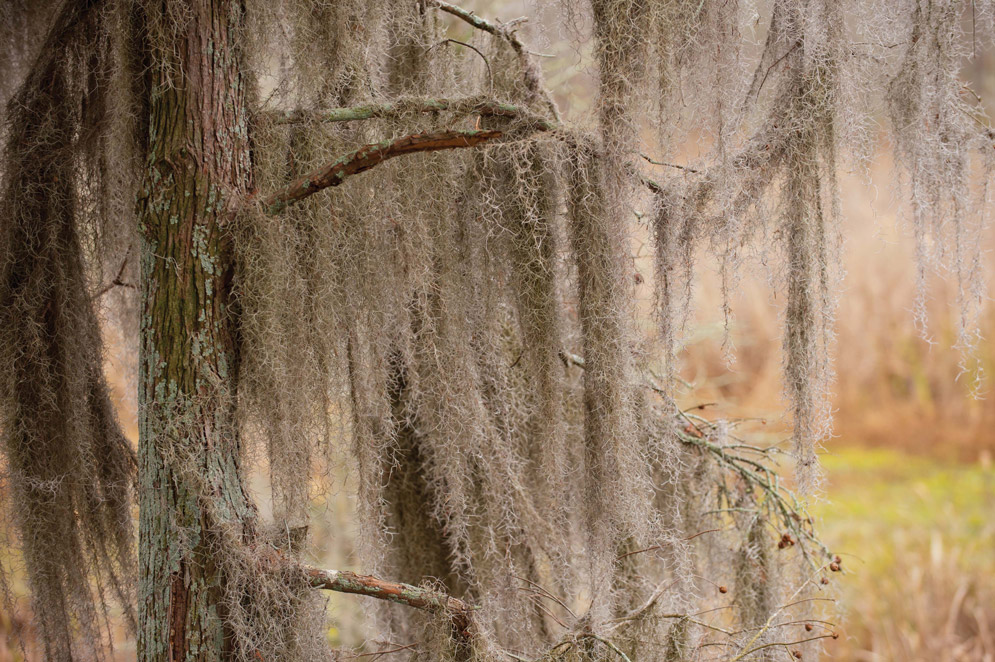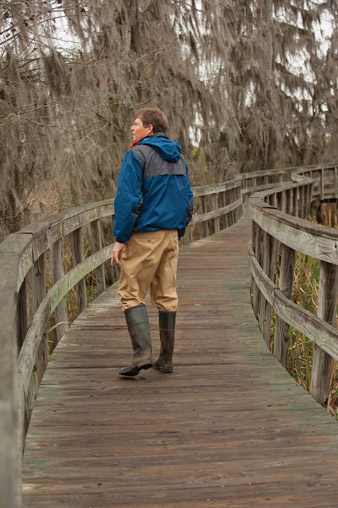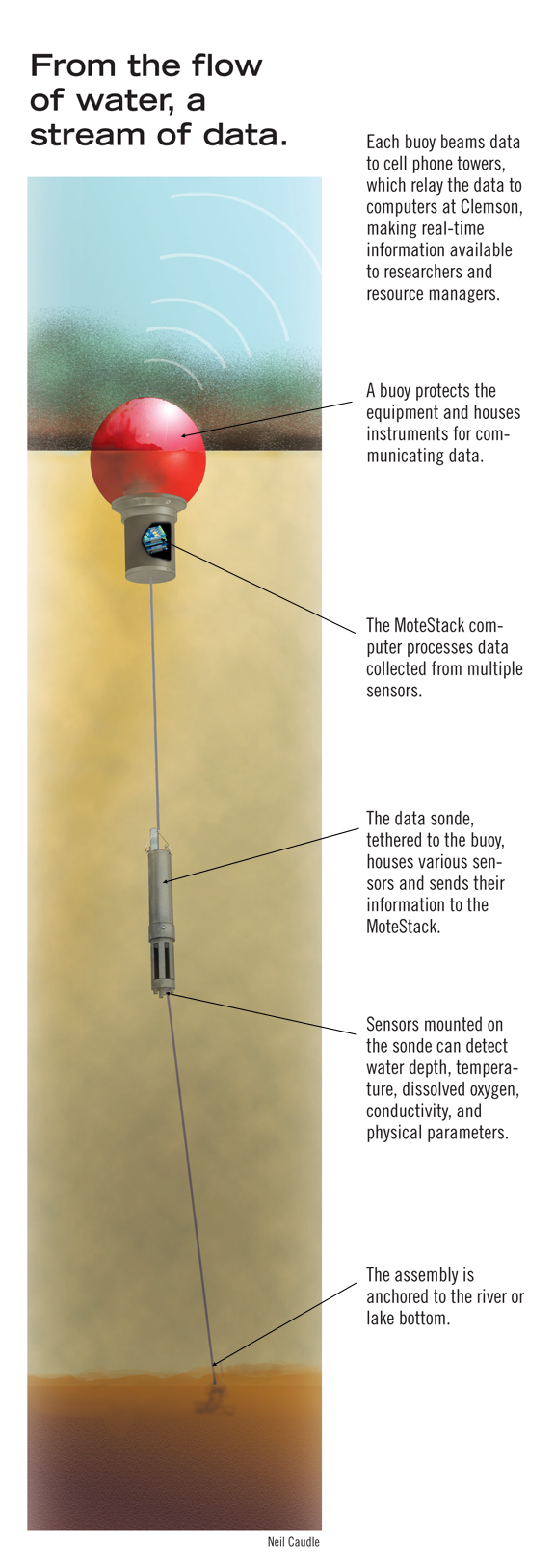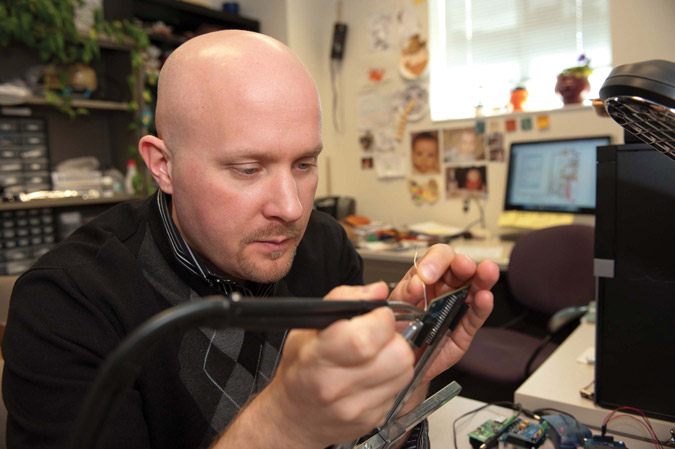of seeds and the river
story by Peter Kent and photos by Craig Mahaffey


Eidson follows a winding walkway into the 1,100-acre Phinizy Swamp Nature Park, which he and a group of Augusta, Ga., residents restored.
From the flow of water, a stream of data

Take a look at the Intelligent RiverR project website to see the MoteStack’s real-time data.

Jason Hallstrom solders circuitry on a MoteStack, a small computer that manages streams of data from environmental sensors. “Anytime you start talking about networking more than five sensors, it’s a challenge,” he says. “Ten is a big problem, and we’re talking about deploying a thousand.”
money and the teachable moment
Peter Kent
On October 20, 2011, Gene Eidson and Jason Hallstrom stood before members of their research team, the media, and Clemson’s board of trustees to announce an award: $3 million from the National Science Foundation for the Intelligent RiverR project. The presentation was seamless and professional, a well-honed talk with vivid color slides.
What it didn’t show was the three-year ordeal that it took to land the cash, and how it very nearly failed to happen.
We won’t usually write very much in these pages about funding. But these days science, especially big science, cannot happen without it. And it just so happens that the funding for the project Eidson and Hallstrom unveiled that afternoon in October has had more ups and downs than a rollercoaster ride.
About six months into the Intelligent RiverR project, Eidson asked Hallstrom what he wanted to get out of the deal. “I told him I wanted an opportunity to lead large-scale programs,” Hallstrom says. He got his chance in 2009. It was one helluva learning experience, he says.
The National Science Foundation awards Major Research Instrumentation (MRI) grants. MRIs usually are big things, like deep space observatories and super colliders. The team decided to write a proposal titled “Development of the Intelligent RiverR, a Basin-Scale Monitoring Instrument.” The $3 million grant application went to the NSF Division of Computer and Network Systems. The funding would pay for the team to design, develop, and deploy the macroscope along the entire Savannah River, from headwaters in North Carolina to the estuary at the Atlantic Ocean.
Before the proposal could go to NSF, it had to be vetted internally by the associate vice presidents and deans for research. Proposals are ranked for likelihood of being funded. It’s not only a matter of improving your odds of success; it’s choosing which projects the university deems worthy of cost sharing. Many grants require the institution to pay thousands, even millions, of dollars as earnest money, a show of good faith that they are serious about supporting the research.
The macroscope made the cut; the proposal went to Washington, D.C.
More confident than prepared
“The first time we submitted we were lucky in a couple of ways,” recalls Hallstrom. “The first year we applied, the MRI program was supported through ARRA federal stimulus funds. This was important for the proposal because it meant there would be no cost-sharing—a $1.3 million roadblock in trying economic times. In retrospect, I think we were also lucky that we weren’t funded. We hadn’t had enough field experience with the technology to understand all of the obstacles we were going to encounter. I question whether we would have been able to deliver.”
Hallstrom says they were more confident than prepared. “We would have been in big, big trouble if we had gotten it on the first submission.”
When the NSF sends a project back, it comes with a critique. Hallstrom went to Washington and met the NSF program manager, who is the make-or-break gatekeeper for funding approval. It was show-and-tell time for an audience of one: Rita Rodriguez. “When I met Rita, I came with our slides and MoteStacks and laid them out on her desk and explained the proposal and our vision,” Hallstrom says. “She was very gracious, and fortunately, she saw where we wanted to go.”
It was a teachable moment for Hallstrom. “When you talk to smart people, they find the flaws in your ideas. At the NSF it’s their job. Your job is to help them understand the proposal and that your university supports it.”
The team felt confident. Now it had to convince the internal review committee to greenlight the application again. This time there was a catch. The economy had tanked and the NSF reinstated the cost-sharing requirement. Clemson was going to have to contribute $1.3 million.
Eidson and Hallstrom were door-to-door salesmen, making the rounds to convince administrators to commit the money. Departments across the university were feeling the economic downturn. The cost-share deal had a third coming from the colleges, a third from the vice president for research, and a third from the participating departments. All three said yes; the proposal headed back to the NSF.
“‘Oh, Jason, this is not a happy call,’ Rita said,” Hallstrom remembers. Rodriguez told him the proposal had ranked number two in 2010, a budget year when only one large MRI was funded in CNS.
In 2011 Hallstrom and Eidson wondered if they would get another chance. There were other Clemson proposals that deserved a shot at funding. If the macroscope was going to go back to the NSF, it meant someone else’s proposal would not.
John Ballato directs COMSET, the Center for Optical Materials Science and Engineering Technologies. It is a hothouse of engineering innovation in optical materials—glass and fibers that carry energy and information in a world where speed and accuracy are deified. COMSET had a proposal at the front of line in 2011, when Hallstrom and Eidson were requesting a third chance.
Ballato thought it over. “I knew the researchers here and I knew where they were on their work,” he says. “I decided that our team wasn’t at the point where they were ready.”
The macroscope was back in the game.
Recommended. No, wait…
Major Research Instrumentation grants are a large category. In 2011, there were some 40 proposals for the review panels to critique. The ranked proposals would have to go through a runoff. The final review is the TOC, which had the ominous sound of a countdown clock’s tick tock. TOC stands for Technical Officers Competition, and it is said to be so aggressive that proposal advocates have been known to leave the room in tears.
The TOC convened. Hallstrom waited.
Two hours later, Rodriguez called. The macroscope would be funded.
“I called Eidson but didn’t tell anyone else,” Hallstrom says. “We wanted to wait until the NSF web page changed, identifying the projects recommended, before we sent out a note to everybody,” says Hallstrom. The page changed. It said “recommended.” The team would get the money.
Congratulations overwhelmed email inboxes. A celebration was set.
Two days before the party Rita Rodriguez called Hallstrom. “She said, ‘Jason, this is a very difficult call. The proposal has been returned from the Office of Integrative Activities (OIA) without funding.’”
The NSF website withdrew “recommended.”
Rodriguez thought there was a chance that the macroscope could recover if they acted quickly. Over the next several days, Hallstrom and the team wrote clarifications explaining a wide range of questions that arose in the final hour and participated in several long discussions with some of the top staff in CNS. The final issue concerned an ill-described expense in the budget. With this final clarification approved, Rodriguez said funding had been reinstated. But the website remained unchanged.
At the celebration Eidson was miserable. “Everybody was congratulating me. I was sitting there thinking, ‘Oh my God, how am I going to explain this? What do I do?’”
Hallstrom went to the NSF website over and over and over again.
Finally, “recommended” returned. They had a project after all.
The NSF’s award abstract for the project included the following statement: “It is evident that the growing mismatch between water supply and demand impacts us all: USA watersheds are in peril! This project does something about it….”
In chilled white hands and fingertips reddened by a raw December rain, Gene Eidson holds the future: scruffy, pea-size packets of potential life. Winter is when the cypress trees drop their seed onto the ground and into tea-colored swamp water.
“Seed rain,” Eidson calls it.
If there’s enough water to carry the seeds to the floodplain, they will take root and grow. “It’s not a sure thing,” says Eidson, who directs the Institute of Applied Ecology. “The way we manage rivers today with flow control, often there’s not enough water to carry the seeds. You can see the results. Floodplains have become populated by poplars and pines where cypress used to be.”
So for Eidson, the story begins in the swamp, with the seeds. “I grew up not far from here,” he says. “An uncle would take me along whenever he came to hunt.”
The swamp was a haven, a living classroom. Eidson learned to how to see the place from Mrs. Forrest, an elderly woman of Native American heritage who befriended him and taught him to look and listen to nature.
“She taught me to ‘think’ like a tree, to think about what that tree needs,” Eidson says, spilling his handful of seeds into the water. “That tree spent a lot of effort producing those seeds, and it evolved with the river over millions of years, so it knows when to drop the seeds at the right time. She taught me to think like a fish, an insect, a bird. It made me imagine what the conditions are to carry on life. It’s all connected. Do something here and it causes something else to happen.”
Into the swamp
He talked about his vision. Gradually, Eidson’s project became their project too. It would change the way we monitor and manage rivers. It would involve developing and deploying remote monitoring sensors connected to each other and to Clemson through a data-transfer system. The information would be displayed not as a snapshot of what had already occurred but in real time. A pollution spill, a fish kill, flood stages—all could be reported within minutes of the incident. And scientists, water managers, government regulators, public safety responders—anyone with a connection to the Intelligent RiverR data network—could view the conditions online.The team would build Clemson’s first macroscope.
The word macroscope was coined in 1975 by French molecular biologist Joël de Rosnay. In the 1979 English edition of The Macroscope: A New World Scientific System, de Rosnay wrote:
We need, then, a new instrument. The microscope and the telescope have been valuable in gathering the scientific knowledge of the universe. Now a new tool is needed by all those who would try to understand and direct effectively their action in this world, whether they are responsible for major decisions in politics, in science, and in industry or are ordinary people as we are.
I shall call this instrument the macroscope (from macro, great, and skopein, to observe).
Eidson named Clemson’s macroscope the Intelligent RiverR, and he would turn it first on the Savannah, the same river whose banks he had roamed as a boy, and the same river he had helped to purge of pollution during his years in Augusta.
Stretching from mountains to the sea, the 312-mile Savannah River slakes the thirst of a burgeoning population, dilutes wastewater from industry and sewage treatment plants, irrigates farms and, oh yes, is home for the biota of the watershed.
Building a macroscope
The macroscope would include a network of remote sensors able to collect, store, and send data on river conditions ranging from water quality and flow to storm-water runoff and pollution discharges. Wireless transmitters would send data on temperature, water clarity, dissolved oxygen, and other environmental indicators to Clemson, where the information would be processed and put up on the Internet. Anyone anywhere in the world could view on a computer—even on a smart phone —the well-being of the river. Watch a video about the Intelligent River project.
“Our goal is to optimize every drop of water—protecting the environment, nourishing the economy,” Eidson says. “We believe we can do it all, but you need data to do that. You need a system.”
The system is being built from scratch, created by an interdisciplinary team of scientists, including hardware developers, software engineers, river ecologists, information technologists, visual-effects designers, forestry and natural resource experts, and economists.
The research challenges are daunting: The goal is to deploy as many as a thousand sensor platforms in the river. The results will create a flood of information that will have to be made meaningful.
Computer scientist Jason Hallstrom works on the macroscope’s brain, the MoteStack, which is a very small, battery-powered computer. Old English for speck or particle, the word mote was used by military researchers to describe smart dust—tiny, low-power, cheap sensors that could be released like a cloud to gather and relay data on battlefield conditions.
Hallstrom called his device a MoteStack because it consists of layers of sensor platforms. The design will let researchers deploy a very large number of sensors and configure them in a network.
The MoteStack itself is not a sensor. It’s a battery-run computer about the size of a Rubik’s Cube and is comprised of stacked circuit boards to power and operate sensors and other electronic components.
While the Intelligent RiverR isn’t the only large-scale sensor network, it will be the largest basin-scale network in the U.S., Hallstrom says. “Anytime you start talking networking more than five sensors, it’s a challenge; ten is a big problem and we’re talking about deploying a thousand.”
Before you begin to think about the ins and outs of moving and massaging vast amounts of real-time data, there are more practical problems. The patent-pending MoteStack needs a very special home.
Environmental information scientist Chris Post leads the work on housing and deploying the MoteStack and linking the web of sensor platforms. The red buoys are designed to deal with all sorts of misfortunes, natural and man made. When heavy rains raise the water level, the buoy submerges to avoid debris. Post also has to contend with vandalism, figuring out how to make the buoys bulletproof and theft resistant.
The team had to puzzle out how to deal with the Achilles Heel of all field sensors: power. Batteries were the traditional energy source, but they were costly not only to replace but also in technician time—trips to sensor sites were draining time and money. Plus, the power problem had to be solved not only for the MoteStack but also for the receiving site onshore. Solar panels are a popular choice, but they can be stolen—as batteries can be—in isolated locations.
The researchers found a way to minimize the power needs by efficiently running each task in the data collection and transmitting sequence. Nothing would use power until needed. They maximized the efficiency of the staggered process and miniaturized the communications hardware, tucking it all inside the buoy. This was a breakthrough.
“When we started the macroscope we had no idea what we were doing in terms of building the hardware,” Hallstrom says. “When you look at early designs, they were total disasters. I still have them on my desk. They’re a mess.”
The newest version of the MoteStack opens the information floodgates, sending a torrent of raw sensor data that must be gathered and configured so that it can be used. Computer engineer Sebastien Goasguen specializes in storing and accessing data.
“The first thing we are going to do is put the Savannah River in the cloud,” Goasguen says. “That means that all the data collected by the sensors we are going to move onto the computer network, so that everybody can access it…We are going to be able to go to the cloud and access data from the Savannah River.”
Access to data is one thing, using them another, Goasguen says. “We are going to be able to use the Palmetto Super Computer to analyze the data and extract knowledge. So I think it will be a terrific resource for the student and the researcher, and we hope it will be a boost for the knowledge economy.”
Data, however, are only valuable when they reliably and accurately represent conditions. Environmental informatics specialist David White oversees the quality-control process. “Data from the sensors will be continuously monitored,” White says. “If results fall outside expected limits, we will examine and diagnose the problem and fix it. Some procedures can be done remotely, but if we need to, someone will go out and check at the river.”
Making sense of the data flood
To the user, Jerry Tessendorf’s role will have big impact on whether or not the Intelligent RiverR makes a splash. Tessendorf is a visual-effects engineer with the exotic credentials of a Ph.D. in physics and designing computer-generated imagery in Hollywood.
“So the Intelligent RiverR will produce a flood of data about the ecosystem of the river,” Tessendorf says. “In order to make sense of all the data, we are building a new computer system that uses the latest technology and graphics processing units to simulate the river system as it might actually be occurring. The level of detail and realism will include moving waves going down the river, bushes and trees blowing in the breeze, animals, plants, and the atmosphere and weather conditions that are appropriate for that moment. And we hope that this will help to better understand how the river ecosystem components work together.”
Tessendorf leads the design of the Intelligent RiverR Viewing Room (IRVR) in the building which houses the Strom Thurmond Institute for Government and Public Policy and the Institute for Applied Ecology. The room will have two banks of high-definition projectors beaming realistic images of the river on curved screens synchronized with a long tabletop display depicting the river. Point to the location of a fish kill, for example, and the projectors will use the sensor information at the location to present an image of the situation. At the end of the room will be a large-screen monitor displaying numerical data to analyze in relation to the imagery.
The IRVR will be a dramatic tool to help viewers grasp the power of the macroscope to present a detailed landscape view of the river. The room will also help recruit clients for the technology and data.
The team tested parts of the macroscope and tried a prototype at a handful sites around the state. Bannockburn Plantation in Georgetown offered the opportunity to try out the system as way to collect data on the environmental impacts of development. A raft of equipment anchored in Lake Issaqueena in the Clemson Experimental Forest tests the configuring sensors on a MoteStack.
The project in Aiken to control storm-water runoff downtown and use sensors to measure water flow and quality has provided encouraging results. It also offered Hallstrom some insights into how his work fit into the big picture.
“Computer science is not known for its social side,” Hallstrom says. “We spend most of our lives sitting in an office, staring at a screen. Building sensor devices in isolation, I had ill-conceived notions of what they could be used for. When you talk to people who might benefit from this technology, it gives you a much better idea of what you ought to be working on.”
Hallstrom is not a person you would kayak the Savannah River with and expect a running account of the flora and fauna. “What I know about river ecology I learned from working with the domain scientists—the ecologists,” he says.
In Aiken, the team set up a network of sensors to collect data on weather, storm water, and soil moisture conditions. The data would be sent wirelessly to Clemson, organized in a database, and viewed via the internet.
“When we walked into the woods it brought the problem into focus when I saw this huge canyon that was carving the woods apart,” Hallstrom says.
Hitchcock Woods is a landmark in Aiken, an equestrian center where the city streetlamps are embossed with horsehead medallions. The woods are known for bridle paths and a unique geographical feature called the Sand River. It is an ephemeral river of sand after rainfalls, a stark example of erosion that leaves a bed of beach-like sand between banks of broken limbs and tree trunks draped with debris disgorged from storm sewers.
“I was stunned,” Hallstrom says. “I saw it was having a fundamental impact on the landscape, and it matters to the people who live there. We had been talking about flow-prescription issues and water flow downstream. And it was amazing to imagine how a little less water downstream could make a tremendous difference.”
It was a critical time in learning how to work as a team, and Gene Eidson was the coach. There were lots of heart-to-heart talks with researchers who had a hard time learning to be one of many or “sticking to the knitting,” as Eidson calls staying on task.
Eidson had his own knitting to do. He applied for and earned the designation of Clemson as an EPA Center for Watershed Excellence, the first in the nation to focus on digital monitoring of water systems, which would be the seed for the Institute for Applied Ecology. He helped the university apply for an endowed chair in sustainable development through the S.C. Centers for Economic Excellence program, which uses lottery revenues to fund research that can help build the state economy. He met with the Clemson University Research Foundation to register the Intelligent RiverR trademark and plan how to patent the results and spinoffs that could come from the research.
“We are creating a technology that will transform the way we monitor both the natural and built environments,” Eidson says. “This is the green economy, and this is the knowledge-based economy. The tools and systems we are developing and using will not only bring a new cost-effective way to monitor resources within our state, they will also bring jobs.”
Hallstrom sees the river technology creating spinoffs. “The same type of technology used to monitor rivers can be used to monitor virtually anything in South Carolina or throughout the world,” he says. “In the future, we are considering MoteStack applications for Intelligent Riverfarming, traffic monitoring, forestry, buildings—the list is virtually endless. We are just starting to understand all the application opportunities that are available.”
Gene Eidson is director of the Institute of Applied Ecology and is a professor in the Department of Biological Sciences, College of Agriculture, Forestry, and Life Sciences. Jason Hallstrom is an associate professor in the Computer Science Division of the School of Computing in the College of Engineering and Science. Other team members include: Chris Post, GIS scientist; David White, environmental informatics; K.C. Wang, wireless computing; Sam Esswein, computational ecology; Jerry Tessendorf, visual effects; Robert Geist, visual effects; Sebastien Goasguen, computer engineer; Jill Gemmill, cyberinfrastructure; Calvin Sawyer, biosystems engineer; Dan Hitchcock, biosystems engineer; Brad Putman, civil engineer; Anand Jayakaran, hydrologist; Ahmad Khalilian, precision agriculture; Oscar Flite, ecologist; Dan Harding, architectural designer; David Pearson, landscape architect; Julia Sharp, statistician; Tom Williams, forestry; William Conner, forestry; and Victoria Chanse, landscape architect.
Primary funding is from the National Science Foundation, Clemson Public Service Activities, and the Clemson Experiment Station. Other partners include the Belle W. Baruch Institute of Coastal Ecology and Forest Science; Clemson University Restoration Institute; Southeastern Natural Sciences Academy; EPA Region 4 (Southeast) Centers of Excellence for Watershed Management; S.C. Centers of Economic Excellence Program; U.S. Army Corps of Engineers, Savannah District; National Park Service, Atlanta District; city of Aiken; Lucille Pate, Arcadia Plantation; Pate Foundation; and the Belle W. Baruch Foundation.
Intelligent RiverR is a registered trademark. MoteStack and the bottom-anchored buoys are patent-pending technologies.
See the Institute of Computational Ecology for more information.



